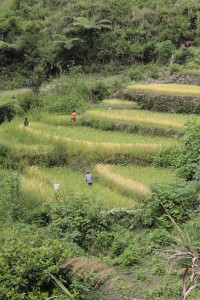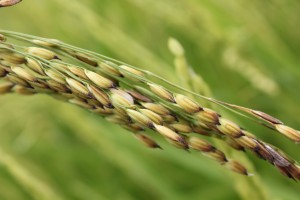 Crispy lechon, fried milk fish, juicy chicken inasal – these are but complements to the main feature on the Filipino supper plate. Taking up nearly three quarters of a meal and most of one’s belly, rice is the star attraction of the Filipino diet. To better appreciate this amazing grain, I decided to travel to northern Luzon to explore the famous rice terraces of Sagada.
Crispy lechon, fried milk fish, juicy chicken inasal – these are but complements to the main feature on the Filipino supper plate. Taking up nearly three quarters of a meal and most of one’s belly, rice is the star attraction of the Filipino diet. To better appreciate this amazing grain, I decided to travel to northern Luzon to explore the famous rice terraces of Sagada.
Accompanied by an eclectic group that was half Filipino, half foreigner, and all female, we set off with snacks and smiles to the Cordillera. The Spanish never made it this far because of the aggressive headhunters in the region, but a map must have influenced the naming of the mountain range. The windy bus ride up is stomach-churning, but the cool fresh air is a relief from the grime and sweat of Manila.
A sign along the road reads “We are adapting to climate change.” Really? Adapting how? I wonder what that means exactly. Excitement winning over skepticism, I can’t wait to get a closer look.
The patchwork of terraces blends into the rugged landscape – a ripe bounty of cabbage, carrots, beans, potatoes, corn, eggplant, and, of course, rice. After traveling upward for hours, we finally have the chance to tromp down by foot into the rice terraces. From far away, the patches are wild, ranging shades of green that look bucolic, almost romantic, but as I come closer you see people working among the high stocks in the steps, working hard.
 My Filipino companions recall, with giggles, an elementary school song Magtanim ay ‘di biro meaning “planting rice is no joke.” And, it’s true, growing rice is not easy. Most of the local rice cultivation is manual from planting to harvesting, with the occasional pedal-thresher used to separate grain from husk. I can only imagine the amount of calories that goes into producing a single serving.
My Filipino companions recall, with giggles, an elementary school song Magtanim ay ‘di biro meaning “planting rice is no joke.” And, it’s true, growing rice is not easy. Most of the local rice cultivation is manual from planting to harvesting, with the occasional pedal-thresher used to separate grain from husk. I can only imagine the amount of calories that goes into producing a single serving.
The difficulty of rice growing is even reflected in language with different terms to describe rice at its different life stages: palay (growing rice), bigas (husk removed), lugaw (porridge style), kanin (ready to eat), and tutong (burned rice stuck to the pot).
Beyond rice, another of Sagada’s unique and macabre attractions is the hanging coffins. As one of our guides put it, “Would you rather be underground suffocated with dirt and darkness or above ground with air and light?” No expert on the afterlife, I choose the latter. The coffins hang horizontally along the entrances to caves, ominous but somehow hopeful. After a steep, slippery hike and some gravity-defying spelunking, we are ready to eat.
Because we are surrounded by farms, the food is fresh, with heaps of vegetables and locally made yogurt-based grilled eggplant dressing. The rice seems tastier, somehow, and maybe local really does taste better. For those unaccustomed to so much rice or those pretending to be on a diet, just ask for “half rice.” But the true dieter knows that “no rice” is the secret to slimming down. Or, you could spend a few months working the terraces and you will be sure to earn your rice.
Planting rice, harvesting rice, and even cooking rice require attention to detail. Too much water and the rice gets mushy, too little and it becomes hard, unwilling to soak up a meal’s juices. Using the fork in my left hand to push rice into the spoon in my right, I’m amazed at all the work that goes into this simple starch.
With a full belly and heady appreciation for rice in all its forms, I head back to the city and back to my research.